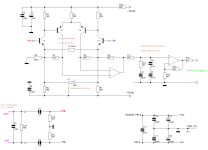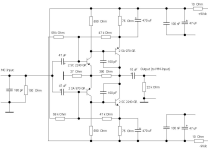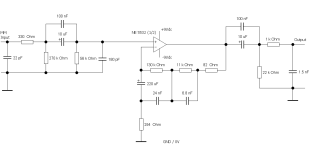Basically,
it is of course also possible to build a multi-stage recovery system.
1) Very low-noise input amplifier, linear
2) 20Hz high-pass filter as ICE recommendation, passive
3) linear buffer amplifier with gain
4) 50Hz /500Hz divider, passive
5) linear buffer amplifier with gain
7) 75µs low-pass filter, passive
8) Impedance converter, buffer
9) Balancer for XLR
all DC-coupled.
This was my favorite EQ between 1992 and 2001, it has seen many replicas, with many different OP-Amp's - but I liked it best with a NE5534 and styroflex capacitors.
it is of course also possible to build a multi-stage recovery system.
1) Very low-noise input amplifier, linear
2) 20Hz high-pass filter as ICE recommendation, passive
3) linear buffer amplifier with gain
4) 50Hz /500Hz divider, passive
5) linear buffer amplifier with gain
7) 75µs low-pass filter, passive
8) Impedance converter, buffer
9) Balancer for XLR
all DC-coupled.
This was my favorite EQ between 1992 and 2001, it has seen many replicas, with many different OP-Amp's - but I liked it best with a NE5534 and styroflex capacitors.
Another dusty box,
with the remains of the first "Minimalist" in a wooden box with inner layers of aluminum foil, copper foil and a special coating with iron particles.
Unfortunately,
there was a problem with the battery charging circuit and the circuit boards were stuck in their screw connections and spacers and could only be broken out - which is why the circuit boards now look a bit strange.
What else can you say about this? This is an illustrative example of what my test circuits often looked like in the past decade: quick and dirty!
The breadboards are stacked up cardboard by cardboard ... maybe a photo one day.
HBt.
with the remains of the first "Minimalist" in a wooden box with inner layers of aluminum foil, copper foil and a special coating with iron particles.
Unfortunately,
there was a problem with the battery charging circuit and the circuit boards were stuck in their screw connections and spacers and could only be broken out - which is why the circuit boards now look a bit strange.
What else can you say about this? This is an illustrative example of what my test circuits often looked like in the past decade: quick and dirty!
The breadboards are stacked up cardboard by cardboard ... maybe a photo one day.
HBt.
Attachments
-
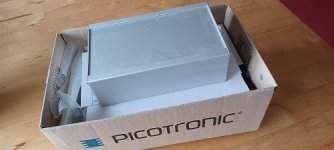 20231210_110037_resized.jpg30.8 KB · Views: 136
20231210_110037_resized.jpg30.8 KB · Views: 136 -
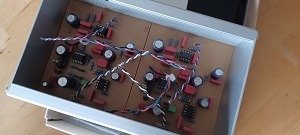 20231210_110112_resized.jpg15.4 KB · Views: 122
20231210_110112_resized.jpg15.4 KB · Views: 122 -
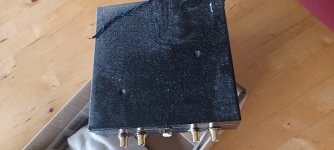 20231210_110145_resized.jpg37 KB · Views: 115
20231210_110145_resized.jpg37 KB · Views: 115 -
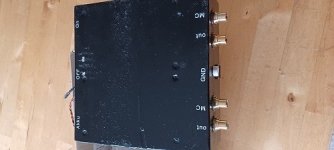 20231210_110209_resized.jpg30.5 KB · Views: 122
20231210_110209_resized.jpg30.5 KB · Views: 122 -
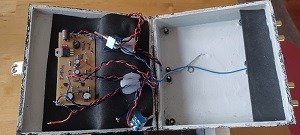 20231210_110303_resized.jpg16.7 KB · Views: 140
20231210_110303_resized.jpg16.7 KB · Views: 140 -
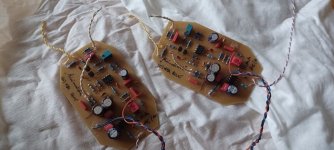 20231210_110422_resized.jpg77.7 KB · Views: 148
20231210_110422_resized.jpg77.7 KB · Views: 148 -
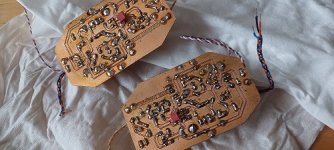 20231210_110506_resized.jpg52.5 KB · Views: 133
20231210_110506_resized.jpg52.5 KB · Views: 133
The narrator could conclude by dropping that Haudegen already installed an EQ in a standard NAD C320BEE in 2011, which almost corresponds to the current Pearl 3.
Coincidences do happen (again and again).
But that's another story.
We will now concentrate on the Post 94 - searching for a suitable name.
😉
Coincidences do happen (again and again).
But that's another story.
We will now concentrate on the Post 94 - searching for a suitable name.
😉
In Greek mythology, Echo (/ˈɛkoʊ/; Greek: Ἠχώ, Ēkhō, "echo",[3] from ἦχος (ēchos), "sound"[4]) was an Oread who resided on Mount Cithaeron
Oread?
Oread?
In search of a name
I would really like a female name for a really beautiful project, but unfortunately the current equalizers lack aesthetics and any charm, they all seem so plump to me. Especially the current pearl number three, I simply miss everything here - but is a great one, I think.
I would charitably describe design #94 as a dwarf. At least since the Ring trilogy (or rather since Bilbo, the little hobbit), all children know that dwarves are cute and honorable. The brute equalization reminds me more of a dwarf, apparently all RIAA EQs are male types than a goddess.
I'm just thinking of "Laurin", whom Knight Dietrich spared. "Hagen", while not a dwarf, is an interesting character - his spear pierced Siegfried (the invulnerable one, the dragon slayer).
"Kyrus" the Great (Persian)? Not possible, it already exists. If you want to name the power supply and amplifier duo, I would perhaps go for "Zethos and Amphion" - or not?
Atalante is my favorite at the moment, but EQ's are male. The current design is robust and not necessarily a delicate beauty, stocky and compact.
A dwarf.
"Oread" is fine, just call it Oread now.
🙂
I would really like a female name for a really beautiful project, but unfortunately the current equalizers lack aesthetics and any charm, they all seem so plump to me. Especially the current pearl number three, I simply miss everything here - but is a great one, I think.
I would charitably describe design #94 as a dwarf. At least since the Ring trilogy (or rather since Bilbo, the little hobbit), all children know that dwarves are cute and honorable. The brute equalization reminds me more of a dwarf, apparently all RIAA EQs are male types than a goddess.
I'm just thinking of "Laurin", whom Knight Dietrich spared. "Hagen", while not a dwarf, is an interesting character - his spear pierced Siegfried (the invulnerable one, the dragon slayer).
"Kyrus" the Great (Persian)? Not possible, it already exists. If you want to name the power supply and amplifier duo, I would perhaps go for "Zethos and Amphion" - or not?
Atalante is my favorite at the moment, but EQ's are male. The current design is robust and not necessarily a delicate beauty, stocky and compact.
A dwarf.
"Oread" is fine, just call it Oread now.
🙂
Dear Chestnutspread!
I think,
we need to deliver and offer a PCB, as well as a euphoric sound description - the like clicks are missing here.
What a bust if the nobele Oread didn't work properly - and CEO Alois freaking out, we must be thinking of his blood pressure. Next year he has an appointment with Bob the Builder, so until then we should ...
We just could sit it out, the usual procedure
Bye,
HBt.
I think,
we need to deliver and offer a PCB, as well as a euphoric sound description - the like clicks are missing here.
What a bust if the nobele Oread didn't work properly - and CEO Alois freaking out, we must be thinking of his blood pressure. Next year he has an appointment with Bob the Builder, so until then we should ...
We just could sit it out, the usual procedure

Bye,
HBt.
I couldn't keep up my schedule but I opened a new thread to follow up the lil Oread and see how well she is doing.
Let's see how she's evolving and if she ends as the nymph we are expecting or a drunk dwarf who needs a shower 😉
I need to sum up the most important parts but here it is: Oread MM Phono Pre
Let's see how she's evolving and if she ends as the nymph we are expecting or a drunk dwarf who needs a shower 😉
I need to sum up the most important parts but here it is: Oread MM Phono Pre
I think, there was still the question of a "reading glasses" in front.
This is really a sensible thing (clever decision) to do:
Our Op-amp sees now the same (source) impedances at its inputs and a perhaps not quite sufficient open loop gain is raised accordingly. Such a configuration can not only be designed with particularly high impedance (jFets), but also with very low noise.
Bipolar or unipolar, it depends ...
At the moment the ancient Dual TVV47 equalizer is present in various forums again.
Since we haven't really decided on a direction in the OREAD thread yet and Haudegen was just looking wistfully back to the 1970s, I let him play with a few components and he create a quasi-current version of this classic. However, the original idea had to be retained, two voltage-boosting stages, single-ended!
We don't know if it works, I'm only allowed to play with plasticine at the moment.

Since we haven't really decided on a direction in the OREAD thread yet and Haudegen was just looking wistfully back to the 1970s, I let him play with a few components and he create a quasi-current version of this classic. However, the original idea had to be retained, two voltage-boosting stages, single-ended!
We don't know if it works, I'm only allowed to play with plasticine at the moment.
Last edited:
We silent discussants have not yet given any thought to the transmission range of the record medium and its playback system.
The old HiFi-DIN45500 page 3 says:
40Hz to 12.5kHz frequency range
Frequency response deviations in relation to the reference value at f=1kHz
+/-5dB (40 to 68Hz)
+/-2dB (63 to 8000Hz)
+/-5dB (8kHz to 12.5kHz)
Crosstalk attenuation at 1kHz
greater or equal to 20dB, in the range from 500Hz to 6.3kHz greater or equal to 15dB
Rumble distance
(to noise) greater or equal 35dB
(to signal) greater or equal 55dB
We should not expect a linear, horizontal frequency response from 20Hz to 20kHz with a constant maximum possible dynamic range.
Today, what are the current limits of the medium and the turntables?
The old HiFi-DIN45500 page 3 says:
40Hz to 12.5kHz frequency range
Frequency response deviations in relation to the reference value at f=1kHz
+/-5dB (40 to 68Hz)
+/-2dB (63 to 8000Hz)
+/-5dB (8kHz to 12.5kHz)
Crosstalk attenuation at 1kHz
greater or equal to 20dB, in the range from 500Hz to 6.3kHz greater or equal to 15dB
Rumble distance
(to noise) greater or equal 35dB
(to signal) greater or equal 55dB
We should not expect a linear, horizontal frequency response from 20Hz to 20kHz with a constant maximum possible dynamic range.
Today, what are the current limits of the medium and the turntables?
In the component / collection box,
just for fun
An instrumentation amplifier with BC550C and BC560C as the first stage ... completely intuitive, a birthday present.
just for fun
An instrumentation amplifier with BC550C and BC560C as the first stage ... completely intuitive, a birthday present.
Attachments
Last edited:
Networks can also be split up:
H(jOmega) =[ 1 + jOmega*R2*C1 / 1 + jOmega*(R1+R2)*C1] * [1 / 1+ jOmega*R3*C2]
with R1=9*R2 it's
very simple and the time constants are known also!

H(jOmega) =[ 1 + jOmega*R2*C1 / 1 + jOmega*(R1+R2)*C1] * [1 / 1+ jOmega*R3*C2]
with R1=9*R2 it's
very simple and the time constants are known also!
Yes, it's the great grandmasters version 😉.
Simple calculation and best possible approximation to the ideal EQ, but no amplification, only attenuation - what do we want to do now to remedy this shortcoming?
Simple calculation and best possible approximation to the ideal EQ, but no amplification, only attenuation - what do we want to do now to remedy this shortcoming?
After all, an unweighted SNR of 78dB is not even that bad - bw=20kHz, with RIAA and A-weighting it is better then 88dB - >that is the (normal) game 😉.
OP-Amp is NE5534
Disclaimer
The circuit shown is only a PRINCIPLE, a simplified schematic!

OP-Amp is NE5534
Disclaimer
The circuit shown is only a PRINCIPLE, a simplified schematic!
Now there's a fairly noisy preamp with its series resistance of 36k (24nV/√Hz), and it has a gain at 1kHz of -20dB too 🙂
Don't exaggerate too much, it's not that bad after all.
Oops, I misread the circuit due to the unusual way the feedback network was drawn - didn't see the gain of the first stage.... I recommend drawing ground at the bottom, not the top - otherwise it looks like the supply rail. You can trip up speed-readers of circuits if you ignore conventions like this.
- Home
- Source & Line
- Analogue Source
- "Haudegen": MM-Phono-EQ
